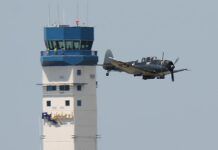Don’t see a video screen? Try disabling ad blockers and refreshing this page. If that doesn’t work, click here to watch on YouTube. |
Last month, nearly 8,000-hour ATP certificated pilot Dale Hemman posted to YouTube multiple views of his 2012 engine-out controlled crash in a Bonanza at Fairbanks, Alaska and, Wednesday, the NTSB released its probable cause report, but questions remain. On the morning of July 26, 2012, Hemman was leading a flight of 12 aircraft on an aerial tour for a group called “Let’s Fly Alaska.” He was flying with one other occupant. Neither was significantly injured in the crash. His aircraft, a 1975 Beechcraft F33A Bonanza modified by D’Shannon Products with a 300-hp Continental IO-550, carried four video cameras — all externally mounted. Each camera recorded a different angle of the events that transpired approximately 41 seconds after the plane began its takeoff roll. They show that while climbing at 400 feet AGL on departure with the gear up, the aircraft lost power. Hemman was faced with several options that included trees and an open field that sat just across a channel of water. It was, possibly, at the optimistic end of the aircraft’s glide range. After an initial roll away from it, Hemman chose the field. It was roughly 90 degrees off his right wing.
Multiple camera angles that include partial views of the aircraft’s elevator along with wind noise suggest Hemman used close to all available airspeed to cross the channel and reach the field. At least one of the cameras appears to break off of the airplane upon impact. Other cameras show the impact and damage suffered by the right wing as a result. The NTSB’s factual report states that the cameras also captured the period of activity that included engine start. The pilot stated that he performed a preflight inspection that included taking fuel samples from the aircraft’s sumps. According to the report the pilot reported that “start, taxi, and the before takeoff checks were all normal with no anomalies.” The factual report also notes that the aircraft sat with the engine running for three minutes and 26 seconds after engine start. It then taxied to the hold short lines of runway 20L at Fairbanks where it sat for another 5 minutes and 30 seconds. The report states that “during this hold short period the audio did not record any sounds consistent with the accident airplane operating at higher RPM’s.” The aircraft’s departure roll began less than 11 minutes after engine start. After the accident the NTSB ran the engine through a magneto check and conducted a series of throttle adjustments from idle to full power. “No hesitation in the engine operation” was noted.
The NTSB listed the probable cause of the accident as “the total loss of engine power for a reason that could not be determined because post accident examination and test run did not reveal any anomalies that would have precluded normal operation.” The cause of the power loss is listed as “Unknown/Not determined.” Hemman has posted the video with comments that conclude, “I hope this video is instructive in some way.”



































